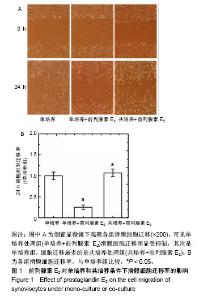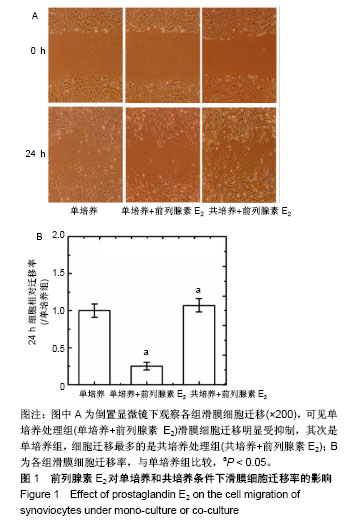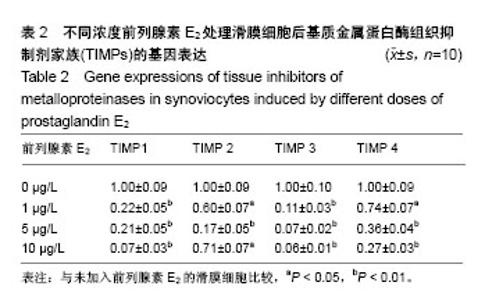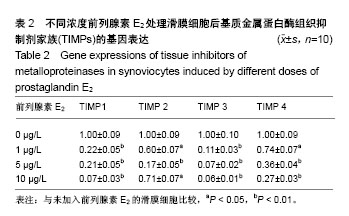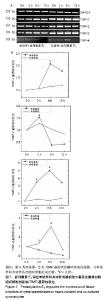Chinese Journal of Tissue Engineering Research ›› 2019, Vol. 23 ›› Issue (13): 2094-2100.doi: 10.3969/j.issn.2095-4344.1692
Previous Articles Next Articles
Effects of prostaglandin E2 in the co-culture of anterior cruciate ligament fibroblasts and synoviocytes
Cai Linyi, Pi Caixia, Xie Jing
- State Key Laboratory of Oral Diseases, West China Hospital of Stomatology, Sichuan University, Chengdu 610041, Sichuan Province, China
-
Revised:2018-11-02Online:2019-05-08Published:2019-05-08 -
Contact:Xie Jing, MD, Associate professor, Master’s supervisor, State Key Laboratory of Oral Diseases, West China Hospital of Stomatology, Sichuan University, Chengdu 610041, Sichuan Province, China -
About author:Cai Linyi, Master candidate, State Key Laboratory of Oral Diseases, West China Hospital of Stomatology, Sichuan University, Chengdu 610041, Sichuan Province, China -
Supported by:the National Natural Science Foundation of China (Youth Program), No. 81600840
CLC Number:
Cite this article
Cai Linyi, Pi Caixia, Xie Jing. Effects of prostaglandin E2 in the co-culture of anterior cruciate ligament fibroblasts and synoviocytes[J]. Chinese Journal of Tissue Engineering Research, 2019, 23(13): 2094-2100.
share this article
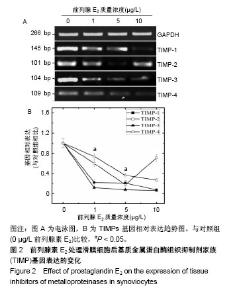
2.2 前列腺素E2以剂量依赖性的方式抑制滑膜细胞中TIMPs的基因表达 半定量PCR结果表明,随着前列腺素E2剂量的增加,TIMPs的基因表达呈现下调趋势,见图2A,表2。对TIMP-1,TIMP-3和TIMP-4而言,其基因表达量在前列腺素E2质量浓度最高时下降至最低,与正常值相比分别下降了93%,94%,73%(P均< 0.05),见图2B。但TIMP-2的基因表达量在前列腺素E2质量浓度为10 µg/L时开始上调(故进行后期单培养和共培养的比较时,选择的前列腺素E2质量浓度为5 µg/L),其基因表达量在5 µg/L前列腺素E2时最低,与正常值相比下降了83%(P < 0.05),见图2B。"
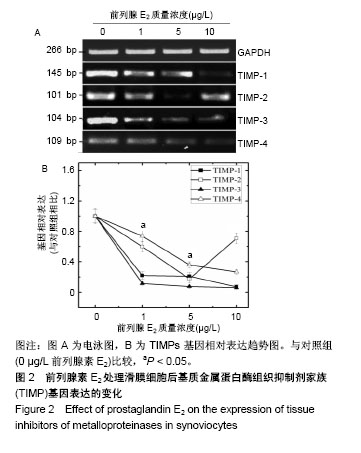
| [1] Ng WH, Griffith JF, Hung EH, et al. Imaging of the anterior cruciate ligament. World J Orthop. 2011;2(8):75-84. [2] Stein V, Li L, Lo G, et al. Pattern of joint damage in persons with knee osteoarthritis and concomitant ACL tears. Rheumatol Int. 2012;32(5):1197-1208. [3] McLean SG, Mallett KF, Arruda EM. Deconstructing the anterior cruciate ligament: what we know and do not know about function, material properties, and injury mechanics. J Biomech Eng. 2015;137(2):020906. [4] Spindler KP, Murray MM, Detwiler KB, et al. The biomechanical response to doses of TGF-beta 2 in the healing rabbit medial collateral ligament. J Orthop Res. 2003;21(2):245-249. [5] Cuellar VG, Cuellar JM, Golish SR, et al. Cytokine profiling in acute anterior cruciate ligament injury. Arthroscopy. 2010; 26(10):1296-1301. [6] Xie J, Jiang J, Zhang Y, et al. Up-regulation expressions of lysyl oxidase family in Anterior Cruciate Ligament and Medial Collateral Ligament fibroblasts induced by Transforming Growth Factor-Beta 1. Int Orthop. 2012;36(1):207-213. [7] Kojima F, Kato S, Kawai S. Prostaglandin E synthase in the pathophysiology of arthritis. Fundam Clin Pharmacol. 2005; 19(3):255-261. [8] Wang P, You X, Yan Y, et al. Cyclic mechanical stretch downregulates IL-1β-induced COX-2 expression and PGE(2) production in rheumatoid arthritis fibroblast-like synoviocytes. Connect Tissue Res. 2011;52(3):190-197. [9] Tsuzaki M, Guyton G, Garrett W, et al. IL-1 beta induces COX2, MMP-1, -3 and -13, ADAMTS-4, IL-1 beta and IL-6 in human tendon cells. J Orthop Res. 2003;21(2):256-264. [10] Xie J, Zhang Q, Zhu T, et al. Substrate stiffness-regulated matrix metalloproteinase output in myocardial cells and cardiac fibroblasts: Implications for myocardial fibrosis. Acta Biomater. 2014;10(6):2463-2472. [11] Xue R, Yang L, Tang Z, et al. The profile of MMP and TIMP in injured rat ACL. Mol Cell Biomech. 2010;7(2):115-124. [12] Tang Z, Yang L, Xue R, et al. Differential expression of matrix metalloproteinases and tissue inhibitors of metalloproteinases in anterior cruciate ligament and medial collateral ligament fibroblasts after a mechanical injury: Involvement of the p65 subunit of NF-kB. Wound Repair Regen. 2009;17(5):709-716. [13] Edwards DR, Beaudry PP, Laing TD, et al. The roles of tissue inhibitors of metalloproteinases in tissue remodelling and cell growth. Int J Obes Relat Metab Disord. 1996;20 Suppl 3:S9-15. [14] Bramono DS, Richmond JC, Weitzel PP, et al. Matrix metalloproteinases and their clinical applications in orthopaedics. Clin Orthop Relat Res. 2004;(428):272-285. [15] Cawston TE, Wilson AJ. Understanding the role of tissue degrading enzymes and their inhibitors in development and disease. Best Pract Res Clin Rheumatol. 2006;20(5):983-1002. [16] Xie J, Wang CL, Yang W, et al. Modulation of MMP-2 and MMP-9 through connected pathways and growth factors is critical for extracellular matrix balance of intra-articular ligaments. J Tissue Eng Regen Med. 2018;12:e550-e565. [17] Wang C, Xu C, Chen R, et al. Different expression profiles of the lysyl oxidases and matrix metalloproteinases in human ACL fibroblasts after co-culture with synovial cells. Connect Tissue Res. 2018,12:1-12. [18] Yan Y, Singh GK, Zhang F, et al. Comparative study of normal and rheumatoid arthritis fibroblast-like synoviocytes proliferation under cyclic mechanical stretch: role of prostaglandin E2. Connect Tissue Res. 2012;53(3):246-254. [19] Spector JA, Greenwald JA, Warren SM, et al. Co-culture of osteoblasts with immature dural cells causes an increased rate and degree of osteoblast differentiation. Plast Reconstr Surg. 2002;109(2):631-642. [20] Wang Y, Tang Z, Xue R, et al. Differential response to CoCl2-stimulated hypoxia on HIF-1α, VEGF, and MMP-2 expression in ligament cells. Mol Cell Biochem. 2012;360(1-2): 35-242. [21] Mullen L, Adams G, Foster J, et al. A comparative study of matrix metalloproteinase and aggrecanase mediated release of latent cytokines at arthritic joints. Ann Rheum Dis. 2014;73(9): 728-1736. [22] 黄长明.影响关节镜下前交叉韧带重建手术疗效的相关因素[J].中国矫形外科杂志,2010,18(20):1707-1710.[23] Ireland ML, Willson JD, Ballantyne BT, et al. Hip strength in females with and without patellofemoral pain. J Orthop Sports Phys Ther. 2003;33(11):671-676. [24] Rieder F, Brenmoehl J, Leeb S, et al. Wound healing and fibrosis in intestinal disease. Gut. 2007;56(1):130-139. [25] Brenmoehl J, Miller SN, Hofmann C, et al. Transforming growth factor-beta 1 induces intestinal myofibroblast differentiation and modulates their migration. World J Gastroenterol. 2009;15(12): 431-1442. [26] Goncharova EA, Billington CK, Irani C, et al. Cyclic AMP-mobilizing agents and glucocorticoids modulate human smooth muscle cell migration. Am J Resp Cell Mol Biol. 2003; 9(1):9-27. [27] Rieder F, Georgieva M, Schirbel A, et al. Prostaglandin E2 inhibits migration of colonic lamina propria fibroblasts. Inflamm Bowel Dis. 2010;16(9):1505-1513. [28] 陈荣富,王春莉,谢静,黄伟,梁熙,宋国立,符纯锋,陈诚.前列腺素E2干预后交叉韧带成纤维细胞和滑膜细胞的迁移[J].中国组织工程研究,2012,16(28):5160-5164.[29] Xie J, Jiang J, Huang W, et al. TNF-α induced down-regulation of lysyl oxidase family in anterior cruciate ligament and medial collateral ligament fibroblasts. Knee. 2014;21(1):47-53. [30] 蔡林奕,孔祥丽,谢强,谢静.NF-κB通路在TNF-α调控软骨细胞MMPs/TIMPs比例中的作用研究[J].四川大学学报(医学版), 2016,47(05):642-648.[31] Zhang YJ, Huang W, Jiang JH, et al. Influence of TNF-α and biomechanical stress on matrix metalloproteinases and lysyl oxidases expressions in human knee synovial fibroblasts. Knee Surg Sports Traumatol Arthrosc. 2014;22(9):1997-2006. [32] Wang C, Xie J, Jiang J, et al. Differential expressions of the lysyl oxidase family and matrix metalloproteinases-1, 2, 3 in posterior cruciate ligament fibroblasts after being co-cultured with synovial cells. Int Orthop. 2015;39(1):183-191. [33] Alameddine HS, Morgan JE. Matrix metalloproteinases and tissue inhibitor of metalloproteinases in inflammation and fibrosis of skeletal muscles. J Neuromuscul Dis. 2016;3(4): 55-473. [34] de Bruyn M, Vandooren J, Ugarte-Berzal E, et al. The molecular biology of matrix metalloproteinases and tissue inhibitors of metalloproteinases in inflammatory bowel diseases. Crit Rev Biochem Mol Biol. 2016;51(5):295-358. [35] Melendez-Zajgla J, Del Pozo L, Ceballos G, et al. Tissue inhibitor of metalloproteinases-4. The road less traveled. Mol Cancer. 2008;7:85. |
| [1] | Zhang Tongtong, Wang Zhonghua, Wen Jie, Song Yuxin, Liu Lin. Application of three-dimensional printing model in surgical resection and reconstruction of cervical tumor [J]. Chinese Journal of Tissue Engineering Research, 2021, 25(9): 1335-1339. |
| [2] | Zeng Yanhua, Hao Yanlei. In vitro culture and purification of Schwann cells: a systematic review [J]. Chinese Journal of Tissue Engineering Research, 2021, 25(7): 1135-1141. |
| [3] | Liu Shaohua, Zhou Guanming, Chen Xicong, Xiao Keming, Cai Jian, Liu Xiaofang. Influence of anterior cruciate ligament defect on the mid-term outcome of fixed-bearing unicompartmental knee arthroplasty [J]. Chinese Journal of Tissue Engineering Research, 2021, 25(6): 860-865. |
| [4] | Xu Dongzi, Zhang Ting, Ouyang Zhaolian. The global competitive situation of cardiac tissue engineering based on patent analysis [J]. Chinese Journal of Tissue Engineering Research, 2021, 25(5): 807-812. |
| [5] | Wu Zijian, Hu Zhaoduan, Xie Youqiong, Wang Feng, Li Jia, Li Bocun, Cai Guowei, Peng Rui. Three-dimensional printing technology and bone tissue engineering research: literature metrology and visual analysis of research hotspots [J]. Chinese Journal of Tissue Engineering Research, 2021, 25(4): 564-569. |
| [6] | Ma Ziyue, Ju Xiaochen, Zhang Lei, Sun Rongxin. Tendon-bone healing in anterior cruciate ligament reconstruction with and without remnant preservation [J]. Chinese Journal of Tissue Engineering Research, 2021, 25(4): 582-587. |
| [7] | Chang Wenliao, Zhao Jie, Sun Xiaoliang, Wang Kun, Wu Guofeng, Zhou Jian, Li Shuxiang, Sun Han. Material selection, theoretical design and biomimetic function of artificial periosteum [J]. Chinese Journal of Tissue Engineering Research, 2021, 25(4): 600-606. |
| [8] | Liu Fei, Cui Yutao, Liu He. Advantages and problems of local antibiotic delivery system in the treatment of osteomyelitis [J]. Chinese Journal of Tissue Engineering Research, 2021, 25(4): 614-620. |
| [9] | Li Xiaozhuang, Duan Hao, Wang Weizhou, Tang Zhihong, Wang Yanghao, He Fei. Application of bone tissue engineering materials in the treatment of bone defect diseases in vivo [J]. Chinese Journal of Tissue Engineering Research, 2021, 25(4): 626-631. |
| [10] | Zhang Zhenkun, Li Zhe, Li Ya, Wang Yingying, Wang Yaping, Zhou Xinkui, Ma Shanshan, Guan Fangxia. Application of alginate based hydrogels/dressings in wound healing: sustained, dynamic and sequential release [J]. Chinese Journal of Tissue Engineering Research, 2021, 25(4): 638-643. |
| [11] | Chen Jiana, Qiu Yanling, Nie Minhai, Liu Xuqian. Tissue engineering scaffolds in repairing oral and maxillofacial soft tissue defects [J]. Chinese Journal of Tissue Engineering Research, 2021, 25(4): 644-650. |
| [12] | Xing Hao, Zhang Yonghong, Wang Dong. Advantages and disadvantages of repairing large-segment bone defect [J]. Chinese Journal of Tissue Engineering Research, 2021, 25(3): 426-430. |
| [13] | Chen Siqi, Xian Debin, Xu Rongsheng, Qin Zhongjie, Zhang Lei, Xia Delin. Effects of bone marrow mesenchymal stem cells and human umbilical vein endothelial cells combined with hydroxyapatite-tricalcium phosphate scaffolds on early angiogenesis in skull defect repair in rats [J]. Chinese Journal of Tissue Engineering Research, 2021, 25(22): 3458-3465. |
| [14] | Wang Hao, Chen Mingxue, Li Junkang, Luo Xujiang, Peng Liqing, Li Huo, Huang Bo, Tian Guangzhao, Liu Shuyun, Sui Xiang, Huang Jingxiang, Guo Quanyi, Lu Xiaobo. Decellularized porcine skin matrix for tissue-engineered meniscus scaffold [J]. Chinese Journal of Tissue Engineering Research, 2021, 25(22): 3473-3478. |
| [15] | Mo Jianling, He Shaoru, Feng Bowen, Jian Minqiao, Zhang Xiaohui, Liu Caisheng, Liang Yijing, Liu Yumei, Chen Liang, Zhou Haiyu, Liu Yanhui. Forming prevascularized cell sheets and the expression of angiogenesis-related factors [J]. Chinese Journal of Tissue Engineering Research, 2021, 25(22): 3479-3486. |
| Viewed | ||||||
|
Full text |
|
|||||
|
Abstract |
|
|||||
